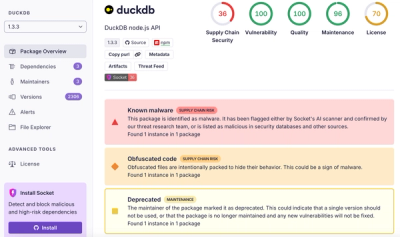
Product
Introducing Tier 1 Reachability: Precision CVE Triage for Enterprise Teams
Socket’s new Tier 1 Reachability filters out up to 80% of irrelevant CVEs, so security teams can focus on the vulnerabilities that matter.

Provides an implementation of today's most used tokenizers, with a focus on performance and versatility.
Bindings over the Rust implementation. If you are interested in the High-level design, you can go check it there.
Otherwise, let's dive in!
pip install tokenizers
To use this method, you need to have the Rust installed:
# Install with:
curl https://sh.rustup.rs -sSf | sh -s -- -y
export PATH="$HOME/.cargo/bin:$PATH"
Once Rust is installed, you can compile doing the following
git clone https://github.com/huggingface/tokenizers
cd tokenizers/bindings/python
# Create a virtual env (you can use yours as well)
python -m venv .env
source .env/bin/activate
# Install `tokenizers` in the current virtual env
pip install -e .
from tokenizers import Tokenizer
tokenizer = Tokenizer.from_pretrained("bert-base-cased")
We provide some pre-build tokenizers to cover the most common cases. You can easily load one of
these using some vocab.json and merges.txt files:
from tokenizers import CharBPETokenizer
# Initialize a tokenizer
vocab = "./path/to/vocab.json"
merges = "./path/to/merges.txt"
tokenizer = CharBPETokenizer(vocab, merges)
# And then encode:
encoded = tokenizer.encode("I can feel the magic, can you?")
print(encoded.ids)
print(encoded.tokens)
And you can train them just as simply:
from tokenizers import CharBPETokenizer
# Initialize a tokenizer
tokenizer = CharBPETokenizer()
# Then train it!
tokenizer.train([ "./path/to/files/1.txt", "./path/to/files/2.txt" ])
# Now, let's use it:
encoded = tokenizer.encode("I can feel the magic, can you?")
# And finally save it somewhere
tokenizer.save("./path/to/directory/my-bpe.tokenizer.json")
CharBPETokenizer: The original BPEByteLevelBPETokenizer: The byte level version of the BPESentencePieceBPETokenizer: A BPE implementation compatible with the one used by SentencePieceBertWordPieceTokenizer: The famous Bert tokenizer, using WordPieceAll of these can be used and trained as explained above!
Whenever these provided tokenizers don't give you enough freedom, you can build your own tokenizer, by putting all the different parts you need together. You can check how we implemented the provided tokenizers and adapt them easily to your own needs.
Here is an example showing how to build your own byte-level BPE by putting all the different pieces together, and then saving it to a single file:
from tokenizers import Tokenizer, models, pre_tokenizers, decoders, trainers, processors
# Initialize a tokenizer
tokenizer = Tokenizer(models.BPE())
# Customize pre-tokenization and decoding
tokenizer.pre_tokenizer = pre_tokenizers.ByteLevel(add_prefix_space=True)
tokenizer.decoder = decoders.ByteLevel()
tokenizer.post_processor = processors.ByteLevel(trim_offsets=True)
# And then train
trainer = trainers.BpeTrainer(
vocab_size=20000,
min_frequency=2,
initial_alphabet=pre_tokenizers.ByteLevel.alphabet()
)
tokenizer.train([
"./path/to/dataset/1.txt",
"./path/to/dataset/2.txt",
"./path/to/dataset/3.txt"
], trainer=trainer)
# And Save it
tokenizer.save("byte-level-bpe.tokenizer.json", pretty=True)
Now, when you want to use this tokenizer, this is as simple as:
from tokenizers import Tokenizer
tokenizer = Tokenizer.from_file("byte-level-bpe.tokenizer.json")
encoded = tokenizer.encode("I can feel the magic, can you?")
FAQs
Unknown package
We found that tokenizers demonstrated a healthy version release cadence and project activity because the last version was released less than a year ago. It has 5 open source maintainers collaborating on the project.
Did you know?

Socket for GitHub automatically highlights issues in each pull request and monitors the health of all your open source dependencies. Discover the contents of your packages and block harmful activity before you install or update your dependencies.

Product
Socket’s new Tier 1 Reachability filters out up to 80% of irrelevant CVEs, so security teams can focus on the vulnerabilities that matter.

Research
/Security News
Ongoing npm supply chain attack spreads to DuckDB: multiple packages compromised with the same wallet-drainer malware.

Security News
The MCP Steering Committee has launched the official MCP Registry in preview, a central hub for discovering and publishing MCP servers.